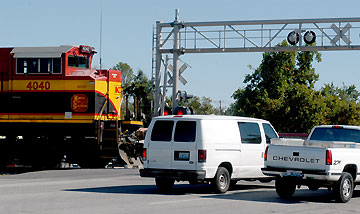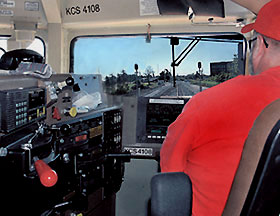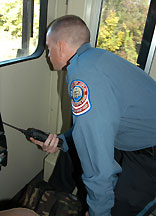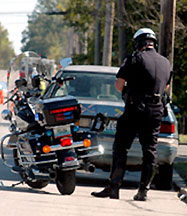
Vehicles wait behind the railroad gates at the 15th Street crossing in Joplin as a long train approaches. While the pick-up in the photo waited for the Kansas City Southern freight train to pass, another just ahead of it had only paused when the gates came down but quickly moved around them. The driver was stopped not far ahead by a Joplin Police officer on a motorcycle. (Photo by Vince Rosati)

The overall view down the track as seen by Kansas City Southern engineer Mark De Graff often is scary as he sees impatient drivers ahead still moving across the train's path even though the flashing red lights have been activated at the crossings.
At a media conference Becky Baltz, head of MoDOT's Joplin office, warned everyone that more than 20 percent of the crashes at railroad crossings in Missouri since 2006 occurred in the Jasper/Newton county area.
According to Randy Beydler, a captain with the Missouri Highway Patrol, Missouri has about 800 trains a day pass over 6400 miles of railroad track and 6800 crossings, and that a motorist is 20 times more likely to be killed in a railroad crossing accident than in an accident with another vehicle.

Grant Caldwell, a Joplin Police Dept. officer trainee stationed on the train that ran from 4th Street to just south of 32nd Street on Thursday morning, calls out the descriptions of vehicles seen entering the crossings after the warning lights started to flash.
Several local law enforcement agencies teamed up once again with the assistance of three railroad lines in a safety exercise dubbed Operation Lifesaver. "We tried education but it wasn't successful," said Rick Moooney, the Operation Lifesaver director. So, for most of the week drivers who broke the law at these crossings were identified and issued a summons that called for a sizable fine and points against their driving records. Speeding up to get over the tracks once the lights start flashing is like running a red light.
"We need to convince drivers to make better decisions," Sgt. Mike Watson of the Missouri Highway Patrol said. Joining with officers from the sheriff's departments of Jasper and Newton counties and the police departments of Carthage, Carl Junction Webb city, Joplin, Neosho and Seneca, Watson saw enforcement as one way to get their message across, but he wanted it to be perceived as "an education," not as "a punishment."

Although 11 officers were working on Thursday, Oct. 16, a traffic officer on a motorcycle stationed just east of the 15th Street crossing was the most effective in chasing down violators who didn't stop for the flashing red signal lights or who ran the gates. (Photo by Vince Rosati)
Operation Awareness, a key element of Operation Lifesaver began on Tuesday, Oct. 13 in Carl Junction and by the end of the day about two dozen tickets for crossing violations were written--17 of them in Joplin, plus about 10 for other violations that incidentally were discovered. One person was taken to the Jasper County jail for stealing railroad property.
Even with the publicity about the program running on TV and in local newspapers motorists continued to run up the tally with at least four more motorists caught breaking the law on Wednesday in the Carthage area and many more on Thursday in the half dozen crossings in Joplin between 4th and 32nd Streets.
Just how much information do motorists need to realize the risk they take in trying to beat the train? Watson said that taking the impact inside of a motor vehicle is one accident you don't want to see. A train has a 4000 to one ratio to a motor vehicle. "That's the same as an auto running over a soda can!"






Comments